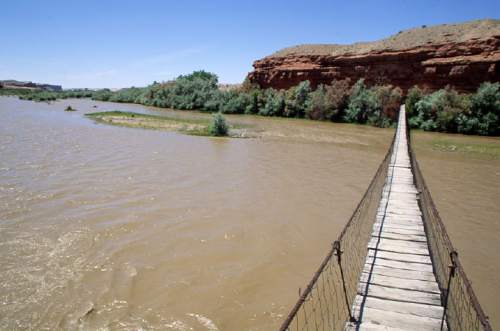This is an archived article that was published on sltrib.com in 2016, and information in the article may be outdated. It is provided only for personal research purposes and may not be reprinted.
The San Juan River runs through a broad flood plain a half-mile south of Bluff, the southeastern Utah town that boasts its founding in the year A.D. 650 — a good 12 centuries before the arrival of Mormon settlers.
That's the time Ancestral Puebloan culture took off, when American Indians began crafting dwellings from rock, mud and juniper in the cliffs along the San Juan and tributaries that flow off Cedar Mesa and McCracken Mesa.
While the ancients lived and worked beside this vital water, the modern town is cut off, access blocked by tracts of private land given to homesteaders who settled the valley in the 1880s.
Now local historic preservationists are seeking to tie the town with the river by arranging easements across various private properties to develop an 8-mile network of nonmotorized trails that would run along the San Juan's north bank downstream to the Sand Island recreation site.
"This is a jewel of a project," said Gary Lichtenstein of the Bluff City Historic Preservation Association. Last May, his group agreed upon a memorandum of understanding with the Bureau of Land Management and the Grand Canyon Trust to work together to make the Bluff River Trail a reality. The trust had helped locals preserve Jones Farm on the upstream side of town.
"It is a real grass-roots effort with multiple stakeholders. Everybody benefits. It is a spectacular stretch of land that shows off this region. When you get out of the politics of it, the world just sparkles," said Lichtenstein, an education consultant who serves on the trail's executive committee.
Land at play includes a few BLM parcels along the river, one of which cropped up in the recently released draft of U.S. Rep. Rob Bishop's Utah Public Lands Initiative Act, or PLI. This 177-acre parcel southeast of town would be conveyed to San Juan County for unspecified "recreational and municipal facilities" under the draft.
The proposed transfer is one of 23, totaling 40,449 acres, to be given to the state and the seven eastern counties mentioned in the PLI.
The appearance of this tract among the PLI's proposed conveyances alarmed Grand Canyon Trust executive director Bill Hedden because, he said, county leaders have expressed an interest in developing ATV trails and wastewater treatment facilities in this area. But local trail proponents aren't that concerned because this parcel has no road access and is surrounded by private land.
"The county may actually be a helpful partner," Lichtenstein said, noting that County Commissioner Rebecca Benally serves on the trail committee.
"The county commissioners and administrators with whom we've met have supported our mission to create a nonmotorized river trail that connects our community and visitors to the natural world that we love," he added.
The project's aim is to create "a remote and peaceful environment for picnicking, fishing, birdwatching, nature appreciation and environmental education [and] public access to the San Juan River from Bluff," according to the memorandum of understanding. Planning has been going on for at least a decade.
The trail would pass by or through world-class rock-art sites, including the one known as Woolly Mammoth, the mouth of a slot canyon and a bird-rich gallery of cottonwoods, Hedden said. "Everybody is quite excited."
The trail would tie Jones Farm with the Sand Island recreation site where BLM operates a campground and launch area for boaters bound for Mexican Hat and beyond to Lake Powell.
Planners envision access from four trailheads, mostly on private ground, and would eventually like separate routes for equestrians and cyclists.
Under its three-way agreement, the historic preservation group would design the trails and draft a management plan that would include signage, trailhead facilities, trail siting, litter control and preventing trespassing onto adjacent private land. The association would also pursue private and public funding.
The Grand Canyon Trust is to spearhead the environmental review and conduct cultural and wildlife surveys, acquire the land, rights of way and easements necessary to complete the network and fund construction to the tune of about $200,000.
This land is subject to flooding, so the trails would not be paved.
"We have set aside funds for constructing the eventual trailheads, and for removal of [invasive] Russian olives and tamarisk where needed," Hedden said.
Grand Canyon Trust's participation is essential because the BLM lacks the resources to complete the environmental analysis and develop the trail and associated amenities, according to Monticello field office manager Don Hoffheins.
"The drive is in the community, and we always like to see that," he said.
Brian Maffly covers public lands for The Salt Lake Tribune. Maffly can be reached at bmaffly@sltrib.com or 801-257-8713.
Twitter: @brianmaffly





